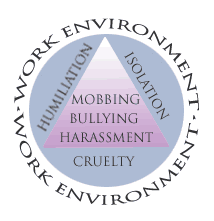INTRODUCTION
Introduces the nature of the mobbing phenomenon, informs about background and history of the research, and the meaning of different terms, i.e. bullying, aggression, harassment.
CHAPTER 1: What Mobbing Is and How It Happens
Describes, analyzes and defines mobbing. Specifies mobbing behaviors. Degrees of mobbing and how it evolves over time. The role of management. Why mobbing is different from any other form of harassment or discrimination.
CHAPTER 2: Why Mobbing Occurs and Persists
Presents reasons from different points of view and attempts to understand the phenomenon from systems thinking: The psychology of the instigators, group dynamics, the workplace structure/culture and the wider society, the role the victim may play in the mobbing.
CHAPTER 3: How Mobbing Affects You
Examines the devastating impact mobbing has on a victim’s health and emotional well-being.
CHAPTER 4: How You Can Cope
Advises victims of mobbing about helpful ways to overcome the experience.
CHAPTER 5: Family and Friends, How They Are Affected, How They Can Help
Describes the potential impact of mobbing on family, friends, and significant relationships. Explains the mobbed person’s state of mind and how support can best be given.
CHAPTER 6: How Mobbing Affects the Organization–Impact and Prevention, The Bottom Line
Offers suggestions for strategies to detect, halt and prevent mobbing from occurring. Recommends modifications to existing human resource policies and procedures.
CHAPTER 7: The Challenge of Conflict Resolution
Analyzes the triggering event–a conflict–of the mobbing syndrome. Discusses the predicament of the attempt to resolve the conflict.
CHAPTER 8: Mobbing and the Law
Addresses the legal framework and current statutes to address mobbing. Concludes with an appeal to lawmakers.
CHAPTER 9: Acting on Awareness
Discusses implications and the cost of the mobbing syndrome to the American economy and society. Specifies the responsibility all sectors of the society have to deal with mobbing, and the role they play in helping to prevent mobbing.





